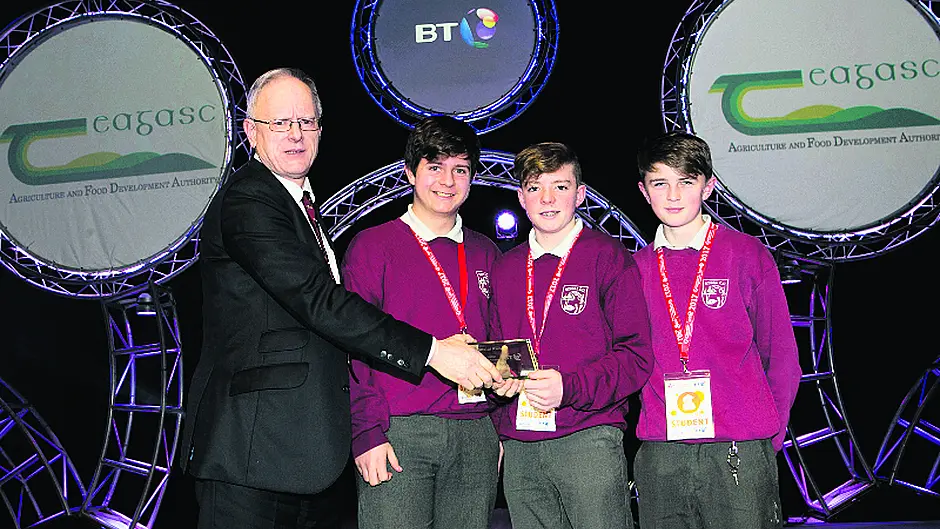Three Schull Community College students won the Teagasc special award at the BT Young Scientist and Technology Exhibition 2017 for their project on agroforestry.
THREE Schull Community College students won the Teagasc special award at the BT Young Scientist and Technology Exhibition 2017 for their project on agroforestry.
Asa Curran, Tiarnan Collins and Jack Ryan-Purcell were also highly commended in their category putting them in the top 15% of entries.
Their project investigated the relatively new land use, agroforestry, and its potential to offset carbon emissions from other agricultural sources. Their science teacher and mentor is Larissa Kelly.
The Teagasc award is presented to the project that best demonstrates a thorough understanding of the science of agricultural or food production, or the use of science to improve technologies available to agricultural or food production.
There were 550 projects accepted to take part in the finals this year from a total of 2,091 entries. The event took place at the RDS, Dublin, with students from 375 schools entered in the competition. Over 60,000 visitors attended the event.
The students were prompted to undertake this project when they heard that Ireland was to face a hefty fine from the EU for failing to meet its carbon emissions reduction targets. They decided to investigate the use of agroforestry (trees are grown in combination with agriculture on the same land) as a possible solution to offsetting some of the emissions associated with agricultural production.
Working with farmer Liam Beechinor in Lyre, Clonakilty, they compared three different land uses for the sequestration of carbon: conventional pasture, agroforestry and conventional forestry for soil carbon.
The students also looked at the amount of carbon stored in the biomass of the trees. They feel that agroforestry is an attractive way for farmers to grow trees without tying up their land in forestry for long periods of time, as agricultural activity can continue beneath the trees.
They found that 3.3% of farm emissions could be offset per year by the growth of agroforestry. They also found that agroforestry resulted in an increase in soil organic matter and therefore carbon.
They concluded that agroforestry could be an attractive way for farmers to offset some of their greenhouse gas emissions by sequestering carbon, thus helping to reduce the levels of greenhouse gases.
The winners will be invited to visit with Teagasc’s Forestry Development Officer John Casey and Eugene Curran from the Forest Service. Teagasc Director, Professor Gerry Boyle congratulated the winners and said: ‘I would also like to congratulate all students who exhibited at the event and I was very impressed with the standards they achieved in their projects.’
Dr Frank O’Mara said that Teagasc is proud to support BTYSTE: ‘We all benefit from raising students’ awareness of the importance of Science, Technology, Engineering and Mathematics (STEM) careers and the career opportunities from taking STEM courses.’
The theme of Teagasc’s stand at BTYSTE 2017 was ‘The Future of Farming and Food’ and was based on the five research prioritisation areas identified in Teagasc’s Technology Foresight 2035 exercise: Plant and animal genomics; human, animal and soil microbiota, digital technologies; new technologies for food processing; and, transformation in the food value chain.
Visitors to the stand were asked to use the interactive stand to give their ideas on technologies for the future.








